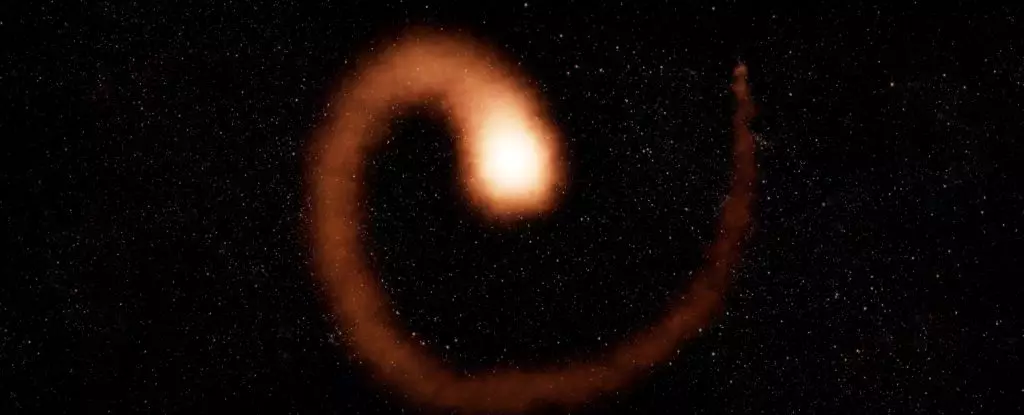In the grand narrative of the universe, the demise of a massive star unfolds like a breathtaking cosmic ballet. Among these celestial titans is Wolf-Rayet 104 (WR 104), a star system that stands out not only for its impending supernova but also for its captivating structure known as the Pinwheel Nebula. The intricate dynamics of WR 104’s binary nature, with a fast-approaching death, present researchers with both a magnificent visual spectacle and a sobering reminder of the cosmic forces at play.
Wolf-Rayet stars are the heavyweights of the stellar world, shining brightly in the night sky and claiming a fleeting existence. Often termed “supernova factories,” these stars symbolize the cyclical nature of stellar evolution, wherein their fiery lives ultimately contribute to the interstellar medium. WR 104, with its astounding mass and relatively brief lifespan, serves as an ideal subject for astronomers probing the death throes of such massive stars.
The Enigma of Binary Interaction
What makes WR 104 particularly fascinating is the binary relationship it maintains with a companion star. Initially understood to be orbiting symmetrically, Grant Hill and his team at the Keck Observatory uncovered an unexpected twist; the wind patterns of these two stars have created a visually arresting spiral. This phenomenon emerges from the gravitational interplay of the two massive bodies, which collaborate to shape the expelled material in striking patterns. The interaction of stellar winds—essentially the gaseous exhalations of these stars—produces magnificent dust spirals, transforming the Pinwheel Nebula into a stunning cosmic artwork.
Originally, astronomers feared that the orientation of WR 104 posed a potential threat to Earth. Should the star explode as a supernova, it could emit a catastrophic gamma-ray burst aimed directly toward our planet. This fear was not unfounded, as the explosive end of a Wolf-Rayet star could spell doom, unleashing radiation capable of undermining our planet’s protective ozone layer. However, the recent findings indicate that our cosmic neighbor is tilted just enough that such a fate appears unlikely for the next few hundred thousand years.
Harmonizing with the Universe’s Mysteries
The revelation regarding the orientation of WR 104, and its newfound position in the cosmos, is a reminder of how unpredictable cosmic studies can be. Often, investigations into such phenomena attract attention with expectations, only for those hopes to pivot dramatically upon unexpected findings. Hill’s research illustrates that while astronomers may capture crucial insights about these celestial bodies, new layers of complexity continually emerge.
Different theories and models can only go so far in explaining the relationship between binary stars and their environmental influences. The unusual tilt is a puzzle, as it suggests that cosmic phenomena are not constrained by our current understanding of astrophysics. Hill’s team had assumed that the stellar winds would result in a more predictable orientation and result. Instead, the misalignment presents a vibrant mystery, one that begs further exploration and theorizing.
The Cultural and Scientific Significance of Stellar Evolution
The study of Wolf-Rayet 104 resonates beyond the realm of raw scientific data; it also echoes through our cultural understanding of stars and their fates. As humanity gazes upward, we grapple with our insignificance in the face of such towering forces. WR 104 serves as a reminder that the universe is a theater of colossal events, and our existence is but a flicker in its vast timeline.
Moreover, the narratives surrounding these massive stars, cast in the light of scientific inquiry, illuminate our pursuit of knowledge. The legacy of WR 104, even as it approaches its end, sparks curiosity and ignites the imaginations of those who seek to comprehend the universe. These cosmic titans not only reveal the beauty of the heavens but also challenge us to confront our understanding of life, destruction, and rebirth amidst the chaos of existence.
In the face of the spins and twists of WR 104’s journey, it becomes clear that even within the deterministic patterns of the cosmos, the thrill of the unknown remains ever-present. Each observation offers clues, but the universe continues to baffle and inspire, opening the door to further inquiry. The legacy of Wolf-Rayet stars emphasizes our ever-evolving relationship with the cosmos—one defined by wonder, hope, and an unending quest for understanding.

